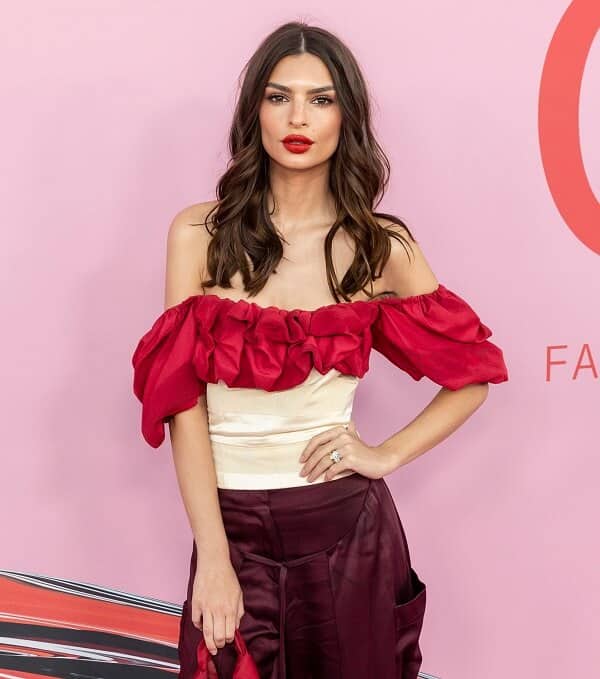Google pushed an article to me this morning that reminded me of two things I often think of the first is how so many people especially the media overestimate the power and intelligence of the tech companies and especially the efficiency an accuracy of AI. the second issue is how completely shallow ignorant and superficial such a large portion of the population is.
so popped up in front of me this morning is an article titled “ Emily Ratajkowski Is a Grand Prix It Girl in a Leather Racing Suit and Matching Bikini” Then follow it up with the byline “The model may be the only one to make a full racing suit look this good”

And my instant thoughts were:
- Who cares? Who reads this stuff?
- I really doubt it
- I haven’t seen this girl since Robin Thicke’s fix Blurred Lines video, and everyone can watch that on YouTube and she has no clothes on so who cares about wearing a leather racing suit over a bikini.
But being that we are a manufacturer of leather racing suits it got my curiosity up enough to see what ridiculous thing the story was about, I was thinking it was basically just good clickbait for Bazaar and other mindless fashion Publications.

so I clicked And as I suspected Emily Ratajkowski Was not wearing a leather racing suit. In fact Not only was it not a racing suit it wasn’t even any piece of apparel that would be worn by a motorcyclist under any conditions.
Bazaar described it as an “oversized leather moto jacket with a white top half and black bottom half.” so right in their own description the words oversized, jacket, top half, and bottom half completely contradict the title of the article that she is wearing a leather racing suit

She was wearing some specially made loose-fitting leather jackets with rather short sleeves with some strange-looking pants that were quite baggy at the bottom. Now I know that the kind of people that write for fashion magazines aren’t exactly rocket scientists nor are they the type of people to ride motorcycles but this is sort of obvious to anyone with an IQ over 99.
My view of how the Fashion Industry Borrows, Steals, and Appropriates Designs from the Motorcycle World in their lame attempt to be “cool”
The culture surrounding the world of motorcycling is very unique. You’ll find that this culture is relatively similar worldwide no matter what country you’re in or what the ethnic, racial, religious, economic, or political background of the rider.
Motorcyclists are usually more independent than the average person and they are also risk takers.
There has always been a sense of rebellion, freedom, ruggedness, and masculinity that have been inherently connected to bikers and their lifestyle.
While there are always exceptions, in general the people in the world of fashion and entertainment have personalities and the mindset quite different from that of a typical motorcyclist. But they love to try to have the moto culture / biker image.
People in the motorcycle industry have become accustomed to the fashion industry and Hollywood “borrowing” from the designs of the motorcycle world. This raises questions about authenticity, appropriation, and the thin line between inspiration and theft.
Origins and Evolution of Motorcycle Fashion

Motorcycle fashion was born when the first motorcyclist was born so that would have been in the early days of the 20th century. And then as now what was paramount to motorcyclists was a project that was half abrasion resistant and durable.
The classic leather jacket, now a staple in the fashion world, was originally developed to protect riders from Abrasion related road injuries and weather elements.
Brands like Schott NYC were pioneers, creating the first leather motorcycle jacket in the 1920s.
Motorcycle Jack is different from regular casual leather jackets in that they often had extra layers of leather and high abrasion areas like the elbows as well as additional padding and more heavy duty zippers than would be found in normal apparel. Leather where is the near perfect material for this purpose and it’s still the predominant material used in motorcycle jackets today.
Mainstream Fashion Appropriation

Has motorcycle culture spread to normal society, and the image of the biker became popularized in such films like “The Wild One” (1953), with Marlon Brando and his iconic leather jacket, the fashion industry took notice. What was once purely functional began to symbolize an edgy, anti-establishment vibe that appealed to a large segment of the public, especially the youth. By the 1970s and 1980s, designers like Ralph Lauren and Calvin Klein had incorporated elements of motorcycle apparel into their collections, borrowing the look of rugged biker gear into fashionable items.
Modern-Day Appropriations
Today, high fashion designers frequently draw on motorcycle aesthetics for inspiration, often blurring the lines between homage and appropriation. Luxury brands such as Balmain, Saint Laurent, and Givenchy have featured motorcycle jackets, boots, and even motifs like the checkerboard racing flag in their runway shows. These items are stripped of their original safety features and redesigned as high-fashion statements sold at premium prices for a customer base that is focused on their appearance and image rather than any function of the product.

Isn’t this a perfect example of Cultural Appropriation
The fashion industry’s use of motorcycle culture imagery raises issues of cultural appropriation. For many in the motorcycle community, their apparel and gear is not just about a cosmetic style but a reflection of a lifestyle, an attitude complete with its own values and history. When fashion designers adopt these elements
For a customer base, it does not share any of the same traits with motorcyclists it’s misleading at best.
Even The Super politically correct “woke” CHAT GPT AI program will answer correctly when asked the question are gays and women overrepresented in the fashion apparel industry.
So the two groups of people that are way overrepresented in the fashion industry happen to be two groups of people that are also way underrepresented in the world of motorcycling.

So when some people are trying to defend cultural appropriation they make the argument that it is really showing appreciation and it is the compliment. But this is not the case with motorcycle culture and the fashion industry as the people primarily employed in the industry do not “appreciate” at all this culture which is traditionally masculine and in so many ways opposed to every social cultural and political thing that they believe in.
Of course, we always have to have a disclaimer for the people who don’t understand the difference between some, all,
many, and most, that there are always exceptions. But generally speaking, it is correct to acknowledge the reality that the world of high fashion is quite removed from the world of motorcyclists.
The key to appreciation, rather than appropriation, lies in how these elements are handled — recognizing their roots and conveying respect for the original culture. And in reality the fashion, celebrity, and entertainment world often actively promote a lifestyle and beliefs completely contrary to these values so that is the opposite of conveying respect.
Ethical (Marketing) Considerations and Collaborations
Some designers and brands are attempting to navigate these waters by collaborating directly with motorcycle brands or by sponsoring motorcycle events and teams. These collaborations are an attempt to build and maintain authenticity where none actually exists. For example, a collaboration between a major fashion house and a major brand of motorcycle apparel can produce a collection that creates an impression to a consumer that they respect and honor the essence of motorcycle culture’s unique heritage.
Conclusion: Emily Ratajkowski and the Cultural Appropriation of Motorcycle Culture
The relationship between motorcycle culture and the fashion industry is it’s just like everything else in Hollywood and all the related industries. It’s about superficiality and making as much money as possible off other people’s ideas even when those ideas are completely contrary to your home. A great example of this is Hollywood’s complete addiction to gun violence, and the promotion of gun culture in their films make money, yet at the same time, practically everybody in this industry opposes private gun ownership or favors much more restrictive gun control laws.
While the fashion world’s obsession with the rebel image of bikers can lead to innovative and exciting designs for celebrities, customers of shopping malls, and big profits it is crucial to remember that they are really just posers trying to live out a fantasy of a culture and lifestyle they will never be a part of.
M/M












